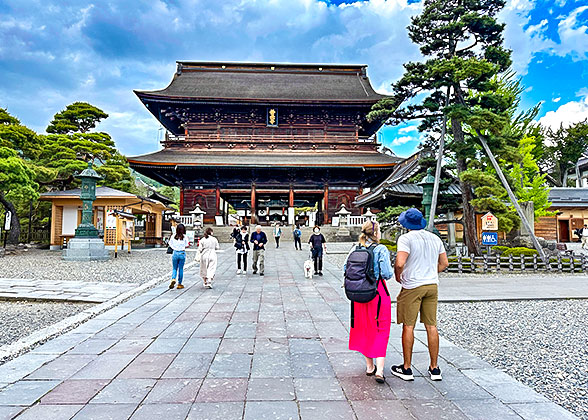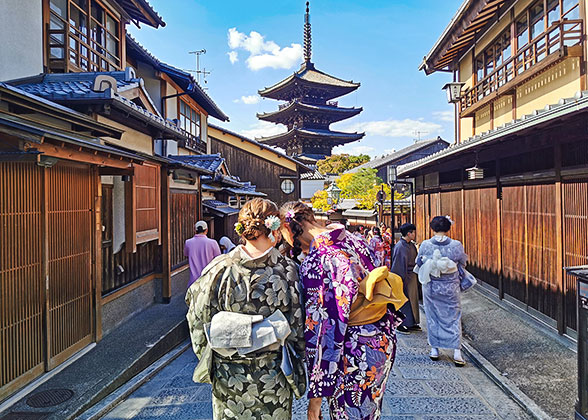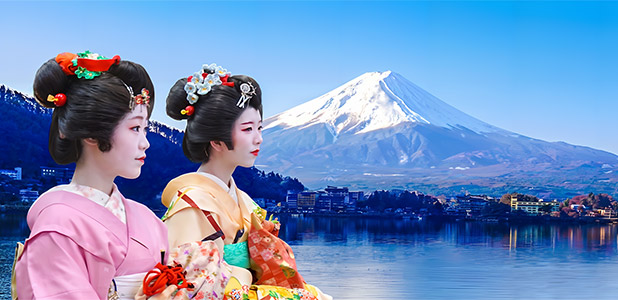Zenko-Ji Temple
Zenko-Ji Temple, built in 644AD, is nearly 1,400 years old. It is the largest wooden temple in Japan and enshrines the first Amida Buddha statue in Japan. As a non-sect Buddhist temple, it is said to bless all people regardless of gender or sect and guide all out of misery. No wonder a Japanese proverb goes that no matter how far away you go, you must visit the Zenko-Ji Temple once.

Zenko-Ji Temple Photos ( 29
|
How did the First Buddha Statue in Japan Come to Zenko-Ji Temple?
Japanese historical records say the Amitabha Buddha statue was originally brought into Japan from India in 552 AD but was thrown into a pond by politicians who advocated abolishing Buddhism. Honda Yoshimitsu, who happened to pass by and rescue the Amitabha Buddha statue, brought it back to his hometown, Shinano, namely Nagano nowadays, and enshrined it. The temple was built in 644 AD under the Emperor of Japan’s rescript and named “Yoshimitsu Temple” after Honda Yoshimitsu. “Zenko-Ji” is a transliteration of the Chinese characters.Secret Buddha and Its Replica
The original statue of the Amida Buddha in Japan is also known as the “Secret Buddha,”- a hidden Buddha statue not shown to the public. Therefore, a replica of the Amitabha Buddha statue named Maedachi Honzon was built in the Kamakura Era (1185-1333) for people to worship. Although a replica, Maedachi Honzon has been cherished by the Japanese. Even the cabinet that houses Maedachi Honzon is a national treasure of Japan.
Zenko-ji Temple in Nagano
Public Display of the Replica Statue Every Six Years
The Maedachi Honzon is displayed publicly every six years in April and May, and such a ceremony is called “Gokaicyo.” The last Gokaicyo held in 2022 attracted about 7 million worshippers and tourists worldwide, and the next will occur in 2028.During the festival, visitors will see a 10-meter-high wooden pillar named Eko-bashira erected in front of the Main Hall. A thread consisting of three segments of white, multi-color, and golden color connects the pillar and the Maedachi Honzon statue. Therefore, as long as you touch the pillar, it is like touching the Buddha Statue, and you can be blessed.
Visit Itinerary in Zenko-Ji Temple
Zenko-Ji Daimon → Niomon Gate → Zenko-Ji Nakamise Street → Sanmon Gate → Zenko-Ji Temple Main HallRoute Length: 650 meters (710 yards)
Time May Needed: 2 hours
|
|
|
Niomon Gate
Walk for about 300 meters (330 yards) along the way, called Zenkoji Omotesando from Zenkoji Daimon, and you will see Niomon Gate. Niomon are regarded as guardians whose statues are set on the left and right sides of the gate. Worshippers will write wishes on straw sandals and hang them before the statues to pray for health.Many retro courtyards and temples enshrining different deities or Buddha statues are on both sides of the way to Niomon Gate, all accessible to visit for free.
Zenko-ji Nakamise Street
Pass the Niomon Gate, and you will get to Zenkoji Nakamise Street, a bustling commercial street filled with various Buddhist supplies shops, souvenir shops and snack bars. You can taste local delicacies and buy souvenirs here.
Sanmon Gate

Zenko-Ji Temple Sanmon Gate
|
Opening Time: 9:00 am to 4:00 pm; 9:00 am to 1:00 pm on Dec.31
Things Worth Doing in Zenko-Ji Temple
Touch the Pindola Statue
You will see a Pindola statue sitting in the Main Hall as soon as you enter. It is believed that people can be cured by touching the same body part of the Pindola statue where they have a disease; thus, the statue becomes very smooth with excessive touches.Watch Morning Buddhist Service O-ASAJI
Morning Buddhist Service is a Buddhist ceremony held every morning in the inner sanctuary. It starts by sunrise- from 5:30 am during late June and late August, gradually moving to 7:00 during late December and late February, and progressively advancing to 5:30 am again.The inner sanctuary visit is accessible one hour before the Morning Buddhist Service and ends from 4:00 to 4:30 pm.
Rosary Blessing: Receive a blessing from the top priest or priestess
Schedule: Four times a day. The first occurs almost the same time Morning Buddhist Service begins, while the following three times depend on applications.KAIDAN Tour: Walk in the dark corridor under the Main Hall
It is said that if you can touch the bliss lock below the central Buddha when walking in the corridor, you are blessed to have the chance to reach the Pure Land.Opening time: The same as the inner sanctuary visit.
Visit the Zenkoji History Museum
It exhibits many utensils and treasures preserved from ancient times or given by others, as well as many Arhat statues. You can see the changes in Zenko-Ji Temple from the past to the present here.Opening Time: 9:00 am-4:00 pm the whole year
Visit the Scripture House

Monks in Zenko-Ji Temple
|
Opening Time: 9:00 am to 4:00 pm; 9:00 am to 1:00 pm on Dec.31
Pray and Draw Fortune Sticks
Visitors can pray and draw fortune sticks for free outside the Main Hall. If you get an unlucky one, you can tie the fortune stick to a shelf, leaving the bad and taking the luck.
Admission Fee
|
Main Hall & History Museum |
JPY600 |
|
Sanmon Gate |
JPY600 |
|
Scripture House |
JPY300 |
|
One Ticket for All |
JPY1200 |
 Tip: You must pay to enter the inner sanctuary for the morning Buddhist service and the KAIDAN Tour. The events themselves are free of charge.
Tip: You must pay to enter the inner sanctuary for the morning Buddhist service and the KAIDAN Tour. The events themselves are free of charge.
How to Get to Zenko-Ji Temple
Step 1: Take Shinkansen to Nagano Station.Step 2: Take a bus bound for Zenko-Ji Temple at Bus Stop #1. It takes 15 minutes and JPY190 for a single-way.
Step 3: Get off at Zenkoji Daimon and walk for about 15 minutes.




